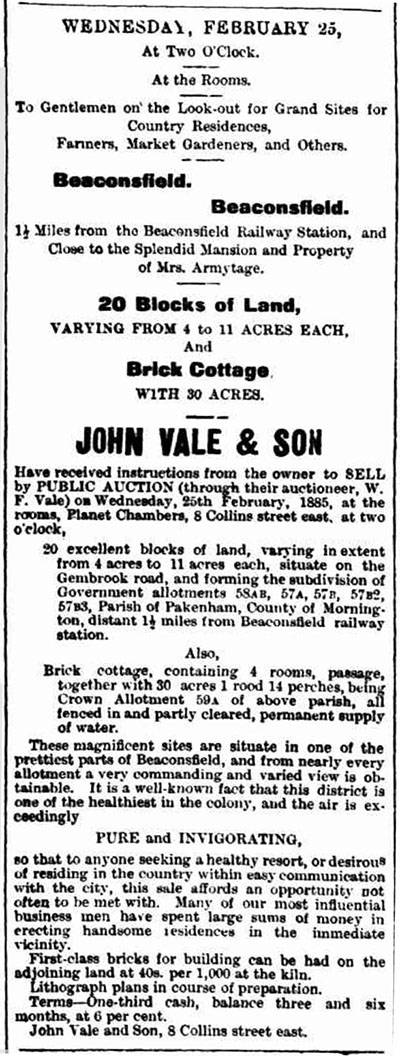
Beaconsfield Heights Estate Company
(Crown Allotments PAK-57A, 57B1, 57B2, 57B3, PAK-58A and 58B)
This land was originally selected by George Miller, who built the Bush Inn Hotel, the predecessor of the Cardinia Park Hotel. In November 1880 Miller was forced to sell the hotel, farm and all the land, as he was declared insolvent. The property was purchased by David Boyd, the sometime owner of Sandown Park Racecourse. Boyd appeared to have planned a subdivision into 31 lots, see plan at http://handle.slv.vic.gov.au/10381/162568. On 25 February 1885 a public auction was held to sell 20 blocks, the remaining blocks were marked as already sold.
This subdivision must have been abandoned, as there are no sales of any of these individual lots registered on the certificate of title. The only land that was sold around this time was the Bush Inn Hotel with 40 acres to Ann Miller and PAK-59A to William Fuller.
In 1884 John Milne married Ann Miller (George Miller's widow), and in 1886 bought the remainder of the land and built the new Cardinia Park Hotel.
Two years later, Dr. L. L. Smith and Dr John Holden Webb bought the land measuring about 296 acres, the transfer being registered on 3 November 1888, but a year later the 5 acres where the hotel stood was returned to John and Ann Milne.
A prospectus for the formation of the Beaconsfield Heights Estate Company was published in the Age on 25 October 1888 and the Argus on 26 October 1888.
William Brisbane would have been the instigator of this venture. In the prospectus it outlined that the property would be bought for £33,000. The advertisement contained the usual exaggerations as to altitude, views, distance from the station etc. The main purpose of the scheme would have been the sand that was able to be mined. Further it was outlined that there was enough firewood on the property to fire kilns to make bricks. Sand was advertised until 1890.
In 1893 the Commercial Bank wanted to recover money provided by promissiory notes (entered on the title as a mortgage)
Application was made to Mr Justice Holroyd in chambers yesterday on behalf of the Commercial Bank of Australia for final judgment in an action against the "Beaconsfield Heights Estate Company Limited to recover £2,554 and interest upon a promissory note made by the defendant company in favour of L. L. Smith and J. H. Webb and endorsed by them to the bank. The defendant asked leave to defend the action. An affidavit was made by William Brisbane acting secretary of the company to the effect that the note sued upon was one of a number given to Messrs Smith and Webb for land purchased from them that in November, 1892, it was agreed that the contract should be cancelled upon the company forfeiting the payments made and giving up the land and the vendors restoring to the company the promissory notes then current and that the deponent was afterwards told by Mr L. L. Smith's solicitor that the bank had promised to give up the note held by it upon the above arrangement being carried out. The land was given back early this year and the company was now without assets of any kind.
Mr Justice Holroyd held that as the bank received no consideration for the alleged undertaking it was not now estopped from suing on the note. He also overruled an objection that the plaintiff had failed to show that the defendant company was a trading company with power to make negotiable instruments. The Court was entitled to infer from everyday experience that companies formed to buy and sell land were trading companies. It was a trade, and sometimes a very dirty trade, too. As the defendant was not prepared to pay the amount of the claim into court, judgment would be entered for the plaintiff with costs.
The Argus (Melbourne, Vic. : 1848 - 1957), Sat 9 Dec 1893, p15
Sometime after this court case the land was transferred to the Commercial Bank. They paid the rates in 1894 and sold the land to John Payne in 1906.